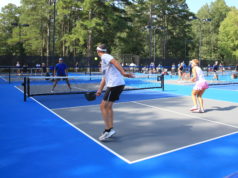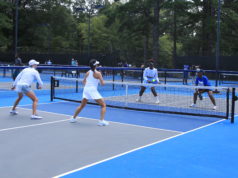By Jim Richards, Smoke Rise Pro
Return tactics depend on serve speed. Assuming the first serve is fast enough to prevent you from hitting short angles or blasting balls at the net player, returns should be hit deep and to the left of the center net strap in the deuce court, and to the right of the net strap in the ad court to avoid the return being poached. Serves that are hit slower give the returner more tactical options, including hitting down the line, lobbing over the net player’s head, and hitting short angle winners. Slow serves also can be treated as approach shots and attacked by moving toward the net. Remember though, the approach shot is the only shot in tennis you should never miss since you are planning to win the point on the next shot at the net.
Who should return in the deuce and ad courts? A lot of variables come into play when deciding which player should return on which side of the court. If most of your opponent’s serves are hit out wide and one player has a better backhand return, then the player with the better backhand return should play the ad side. You both want to be hitting your stronger shot most of the time. Also, the player who gets more nervous should play the deuce court because it will be easier for him or her to win the odd point on that side than trying to win game points all the time in the ad court.
But if your opponents can serve to either your forehand or backhand sides then the stronger, more consistent returner should play the deuce court. Here are a few reasons why:
In doubles, the ad court is the amateur side. It is always the deuce court player who makes the ad court player famous. Using a baseball analogy, the deuce court is the left field; the ad court is the right field. The worst kid on a baseball team is put in right field to “pick daises” because not many balls go into right field. I am not saying you should put the better player in the deuce court. Put the more consistent player in the deuce court, especially when it comes to returning serve.
However, time after time in doubles – especially in mixed doubles – the macho male ego will take the ad court. If both the male and female player have a poor backhand return, the male’s return is protected more. The male player has a more forgiving setup because when he pulls the backhand return horizontally, he has a better chance of getting the backhand return cross court away from the net person. Hitting the backhand return from the deuce court, however, is the most challenging return in doubles. So, when the female pulls the backhand return horizontally playing in the deuce side, the ball goes to the net player.
Sliding over to hit more forehand returns would have a negative consequence if the server came to the net after the serve because it leaves the returner’s side of the court wide open. This is why many times on the pro tours, the male player is in the deuce court.
The stronger, more consistent returner should play the deuce court because more balls will go to the deuce court. Most players are right-handed and are looking to hit forehands. And most players hitting a forehand don’t get their racquet below the ball so they pull their racquet horizontally, causing balls to go into the deuce court. Also, most forehand volleys have a continental grip causing the racquet face to point toward the deuce court.
Because of the scoring system, the stronger, more consistent returner should play the deuce court. Who takes more returns, the deuce court or ad court player? It’s the deuce court player. The points start in the deuce court, so the deuce court players are always ahead of the ad court player in points played.
Try “ghost doubles” to reinforce return tactics: In this drill, there are no net players (ghosts). Instead, the server and returner play out points by hitting diagonally cross court to each other.
Ghost doubles is the best way to train return tactics.




